Harry S. Truman Sports Complex
Introduction
Text-to-speech Audio
In 1967, Jackson County voted to approve a bond that would fund the construction of The Harry S. Truman Sports Complex. The complex houses two stadiums - Arrowhead Stadium opened in the fall of 1972 and is the home of the National Football League’s Kansas City Chiefs, while Kauffman Stadium opened in the spring of 1973 and is home to Major League Baseball’s Kansas City Royals. At the time, many cities across the country had designed multi-purpose stadiums that housed two teams in one home, but Kansas City went in a new direction. The idea for the Truman Sports complex was conceived in 1960s by Denver architect Charles Deaton, Chiefs General Manager Jack Steadman, and architecture firm Kivett & Myers, along with design input from Chiefs owner Lamar Hunt. Initial plans for the complex featured a rolling roof that would cover both stadiums, but the idea was scrapped after considering the cost of such a feature. The complex was the first of its kind and became an example for modern-day sports architecture.
However, with the recent sale of the Kansas City Royals to a new ownership group, the Truman Sports Complex is in danger of losing one half of its components. In August of 2019, an ownership group led by John Sherman purchased the Royals and announced plans to construct a new stadium in the downtown area of Kansas City. A drastic change to the sports scene and Kansas City is coming, and although the move is years away it has certainly created a divide in the community.
Images
Aerial view of the Stadiums housed in the Truman Sports Complex in Kansas City, Missouri.
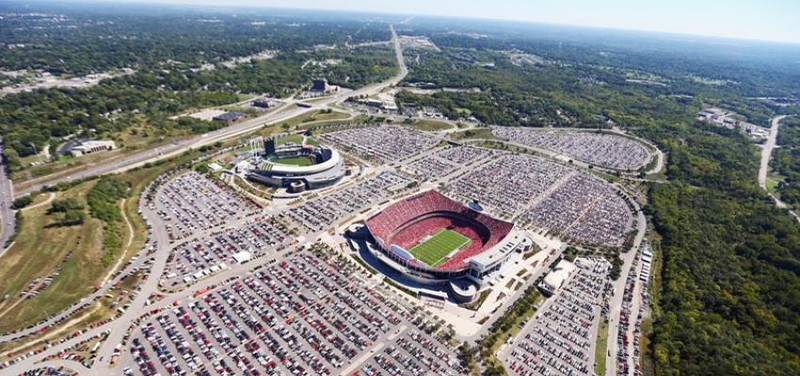
Initial plans for the complex featured "rolling roofs" to cover both stadiums.
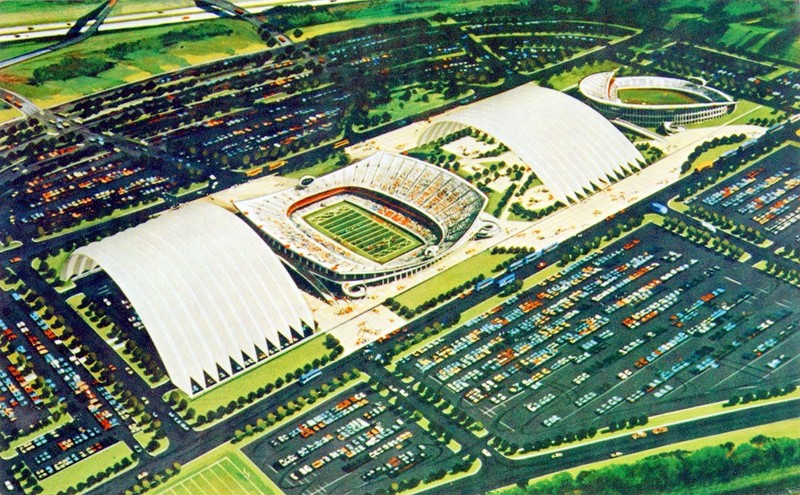
View from behind home plate of Kauffman Stadium.
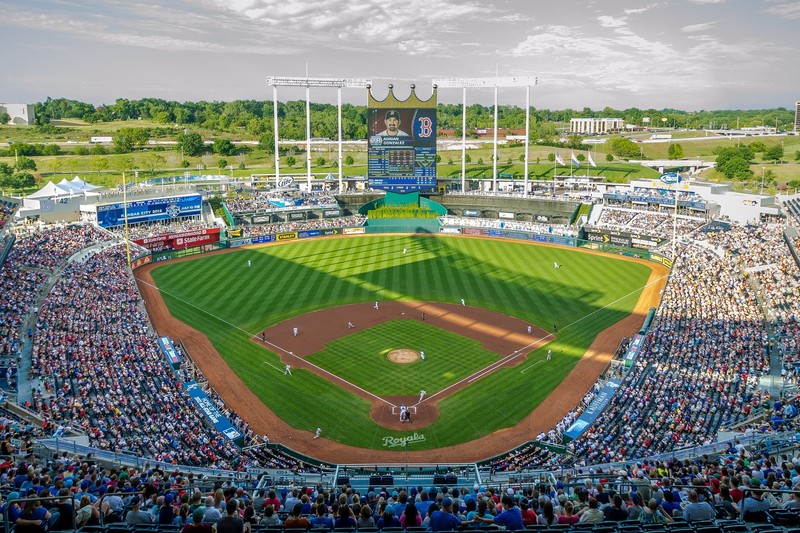
Undated - older photo of the stadiums housed in the Truman Sports Complex
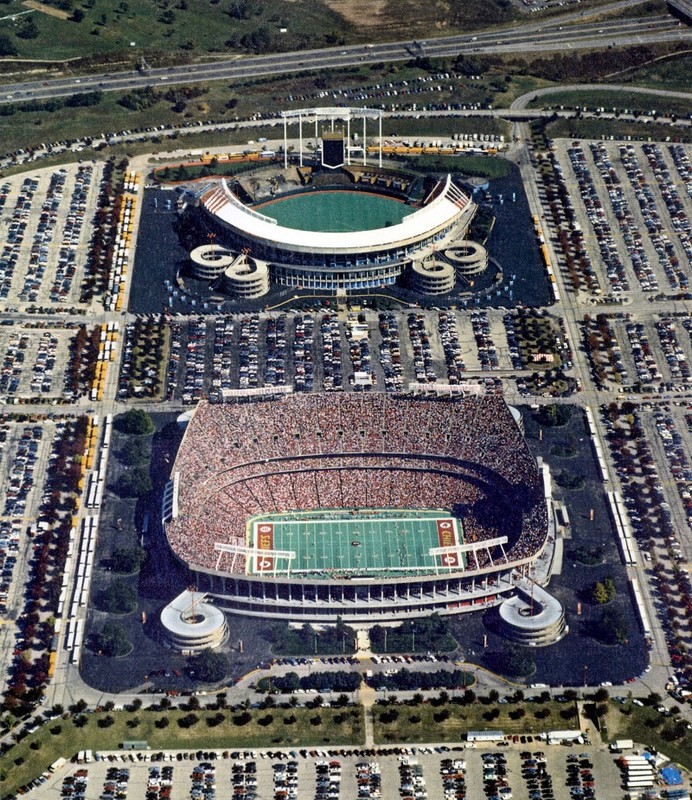
Royals owner John Sherman speaking to reporters after his purchase of the team
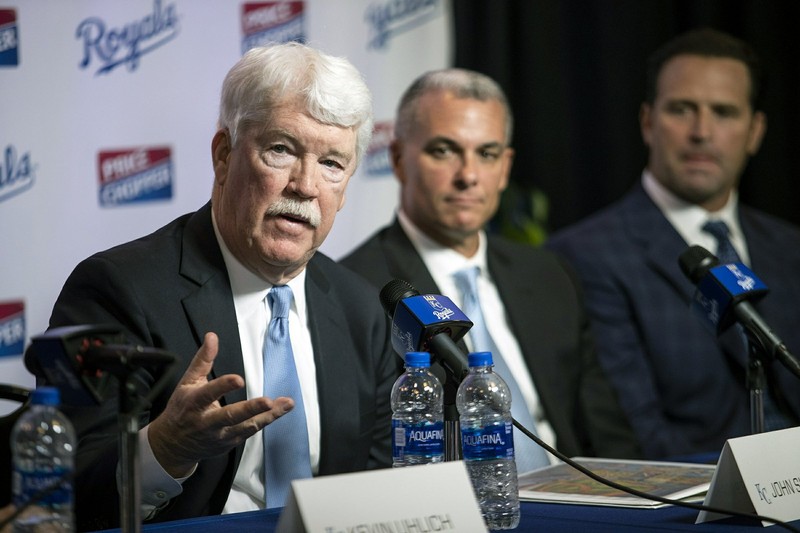
Backstory and Context
Text-to-speech Audio
Affectionately known as “The K” to the people of Kansas City, Kauffman Stadium has remained as a signature spot to sports fans. In 1973, baseball returned to Kansas City with the opening of Kauffman Stadium as one half of the Truman Sports Complex. In 1993, the stadium was renamed after the passing of the man responsible for its construction, Ewing Kauffman. In 2008 and the years following, stadium-goers saw Kauffman Stadium undergo a massive renovation project, and today the park is held as one of the best venues to watch a baseball game at. Beautiful fountains run along nearly the entire length of the outfield and are overshadowed by a massive jumbotron dawning a golden crown at its peak. It is truly one of the most unique sports venues in the country, and one that embodies the “City of Fountains” aesthetic that Kansas City is known for.
Kauffman Stadium has housed the Kansas City Royals for the last 49 seasons, but the 50-year milestone could be the last one the stadium will hit, although the Royals and the Chiefs both have leases that tie them to the Truman Sports Complex until 2031. In September of 2021, the ownership group led by Kansas City businessman John Sherman announced that the group is “exploring options” to move the team to a downtown location and construct a new stadium.
The construction of the stadium in a downtown area has become a trend among professional sports organizations in recent years, with the Atlanta Braves and the Minnesota Twins as the most recent examples of teams who have relocated to their downtown cities. John Sherman has discussed his ownership group’s plans in more detail ever since he made the announcement of exploring the possibility of moving the team, “Sherman said the process of deciding where the club will play will be driven by measurable community impact, measurable economic growth and a positive impact on the quality of life for Kansas Citians”. A downtown stadium would instantly become a heavy influence on the creation and improvement of business in the area, and the economy.
Kauffman stadium has been a part of two revivals of Baseball in Kansas City, with the first being the move of bring the Royals back to Kansas City in 1969. The expansion team was successful in its early years, as they were a regular contender in the playoffs and capped off a run of winning baseball with a World Series Championship in 1985. Then, the drought happened.
For nearly 30 consecutive years, the Royals failed to have a single winning season. Up until 2014, the Royals had become a source of humor for the baseball fans of other teams in the country, but Royals fan felt nothing but the pain of having a losing sports team. The 2014 Royals team finally ended that drought, as they wound up running through the playoffs before eventually losing in Game 7 of the World Series, which took place at Kauffman Stadium. The following 2015 season the Royals accomplished a rare feat by making a second consecutive World Series and winning the title for the first time since 1985. Kansas Citians will never forget that championship parade, as it signaled the second revival of Royals baseball at The K.
This is arguably the top reason that fans oppose a move to a downtown ballpark. Kauffman Stadium is an enormous source of positive and nostalgic memory for the sports community in the states of Missouri and Kansas, and people do not want to lose it. The iconic image of jumbotron and the bursting fountains are among the first things to come to a sport’s mind when they think of the stadium. Often, cities move teams or construct new stadiums because there is a need for it. Stadiums get old, and new venues are needed. Kansas City does not have that problem, however. Renovations on Kauffman Stadium and Arrowhead stadium were completed in recent years, which extended the lease of both teams to the Truman Sports Complex through 2031. The ballpark is new and is one of the most unique in all of sports.
The biggest hurdles for John Sherman and his ownership group to clear would be the location for a new stadium, and funding. A new stadium for the city would not be cheap, and among the biggest reasons for hesitancy among Kansas Citians is the issue of funding a new stadium. According to Sherman, the potential construction of a downtown stadium would be funded by a public-private partnership, and he expects that taxpayers would be involved. Nowadays, new sports stadiums cost hundreds of millions of dollars, and some even cost over a billion dollars. The total amount in which the taxpayers would be on the hook for is the critical question in this scenario. According to an article from PBS, many economists maintain that cities that are responsible for helping fund new stadiums rarely get their money’s worth. For example, St. Louis is still paying for the Edward Jones Dome that opened up in 1995, even though their team left for Los Angeles in 2016.
Funding also begs the question of whether Kansas City is ready for a downtown ballpark. Many Kansas Citians state that parking and public transit would become a nightmare in the future. The construction of a stadium in downtown would only make those issues worse in the short term, and possibly lasting for years. Many journalists in the Kansas City area have also stated that Kansas City could use funding in other areas of the city’s infrastructure. The sentiment of “if it ain’t broke, don’t fix it” has been a common line thrown around in newspaper articles recently. The Truman Sports complex allows easy access for fans and provides a massive space to gather and experience the classic Kansas City tailgating scene.
A potential move of the Royals would also affect the Chiefs, who are the Royals’ neighbors at the Truman Sports Complex. If the Royals receive tax dollars for a new downtown stadium, though, it’s believed the Chiefs would want a piece of the monetary pie, according to the Kansas City Star. Current Chiefs Chairman and CEO Clark Hunt discussed in a recent press conference that the Chiefs will watch as the Royals undergo their potential moving process, and that in a year or so the Chiefs will begin to think about what is next for them and their stadium situation. Hunt continued to say that if the Royals were no longer at the Truman Sports Complex, that the amount of freed-up space could allow the team to do some “different programming” that they haven’t been able to do in the past.
No matter what happens in the next decade, Kansas City will be changing. Not just in the sports community, but the general population of Kansas City as well. Kansas City is a growing metro area, and John Sherman’s ownership group wants to capitalize on that, even if it means the legacy of Ewing Kauffman, Lamar Hunt, and the Truman Sports Complex could be forgotten.
Sources
English, Mary. “Here’s a Better Way to Help Improve Kansas City than a New Baseball Stadium Downtown.” The Kansas City Star. The Kansas City Star, September 21, 2021. https://www.kansascity.com/opinion/readers-opinion/guest-commentary/article254303653.html.
Grathoff, Pete. “Royals Fans Share Thoughts about a ... - Kansascity.com.” The Kansas City Star. The Kansas City Star, September 15, 2021. https://www.kansascity.com/sports/spt-columns-blogs/for-petes-sake/article254248728.html.
Helling, Dave. “Is Downtown Kansas City Baseball Worth It? Good Luck Finding out the Real Price Tag.” The Kansas City Star. The Kansas City Star, October 19, 2021. https://www.kansascity.com/opinion/opn-columns-blogs/dave-helling/article255094407.html.
“Kauffman Stadium, Kansas City Royals Ballpark.” Ballparks of Baseball - Your Guide to Major League Baseball Stadiums. Accessed December 7, 2021. https://www.ballparksofbaseball.com/ballparks/kauffman-stadium/.
“KC Q Tackles History of Arrowhead, Kauffman Stadiums. See How They Set the Standard.” Kansas City Public Library, August 7, 2019. https://kclibrary.org/blog/kc-q-tackles-history-arrowhead-kauffman-stadiums-see-how-they-set-standard.
Kerkhoff, Blair. “KC Royals ‘Need to Start Thinking’ about a New Stadium, Possibly Downtown, Owner Says.” The Kansas City Star. The Kansas City Star, September 14, 2021. https://www.kansascity.com/sports/mlb/kansas-city-royals/article254235483.html.
McDowell, Sam. “How Clark Hunt Believes a Downtown Baseball Stadium Might Affect His Kansas City Chiefs.” The Kansas City Star. The Kansas City Star, November 18, 2021. https://www.kansascity.com/sports/nfl/kansas-city-chiefs/article255924886.html.
Mellinger, Sam. “Could a Downtown Stadium for the Royals Mean a New Kansas City? Here’s What We Know.” The Kansas City Star. The Kansas City Star, October 17, 2021. https://www.kansascity.com/sports/spt-columns-blogs/sam-mellinger/article254948422.html.
Newcomb, Tim. “Kansas City: The Story of the Sports Architecture Capital of the World.” Forbes. Forbes Magazine, October 30, 2019. https://www.forbes.com/sites/timnewcomb/2019/10/29/kansas-city-the-story-of-the-sports-architecture-capital-of-the-world/?sh=7a9e2aec387c.
Povich, Elaine S. “Why Should Public Money Be Used to Build Sports Stadiums?” PBS. Public Broadcasting Service, July 13, 2016. https://www.pbs.org/newshour/nation/public-money-used-build-sports-stadiums.
Zinke, Karl. “Ahead of Its Time - Royal Helped Build First Two-Stadium Facility .” Sportsmonthly. The Examiner, January 16, 2005. https://web.archive.org/web/20070929012428/http://www.sportsmonthly.net/stories/011605/Spo_011605016.shtml.
https://visitkcd8.s3.us-west-2.amazonaws.com/s3fs-public/styles/slider_850x400_/public/30331_20456.jpg?itok=ollGZ8UE
https://kclibrary.org/sites/default/files/Truman%20Sports%20Complex%20with%20Rolling%20Roofs-1967.jpg
https://www.ballparksofbaseball.com/wp-content/uploads/2016/03/kauff15952.jpg
https://kclibrary.org/sites/default/files/Truman%20Sports%20Complex-undated.jpg
https://storage.googleapis.com/afs-prod/media/50884ecc37bb43448492eb399cfb9ebf/2000.jpeg
